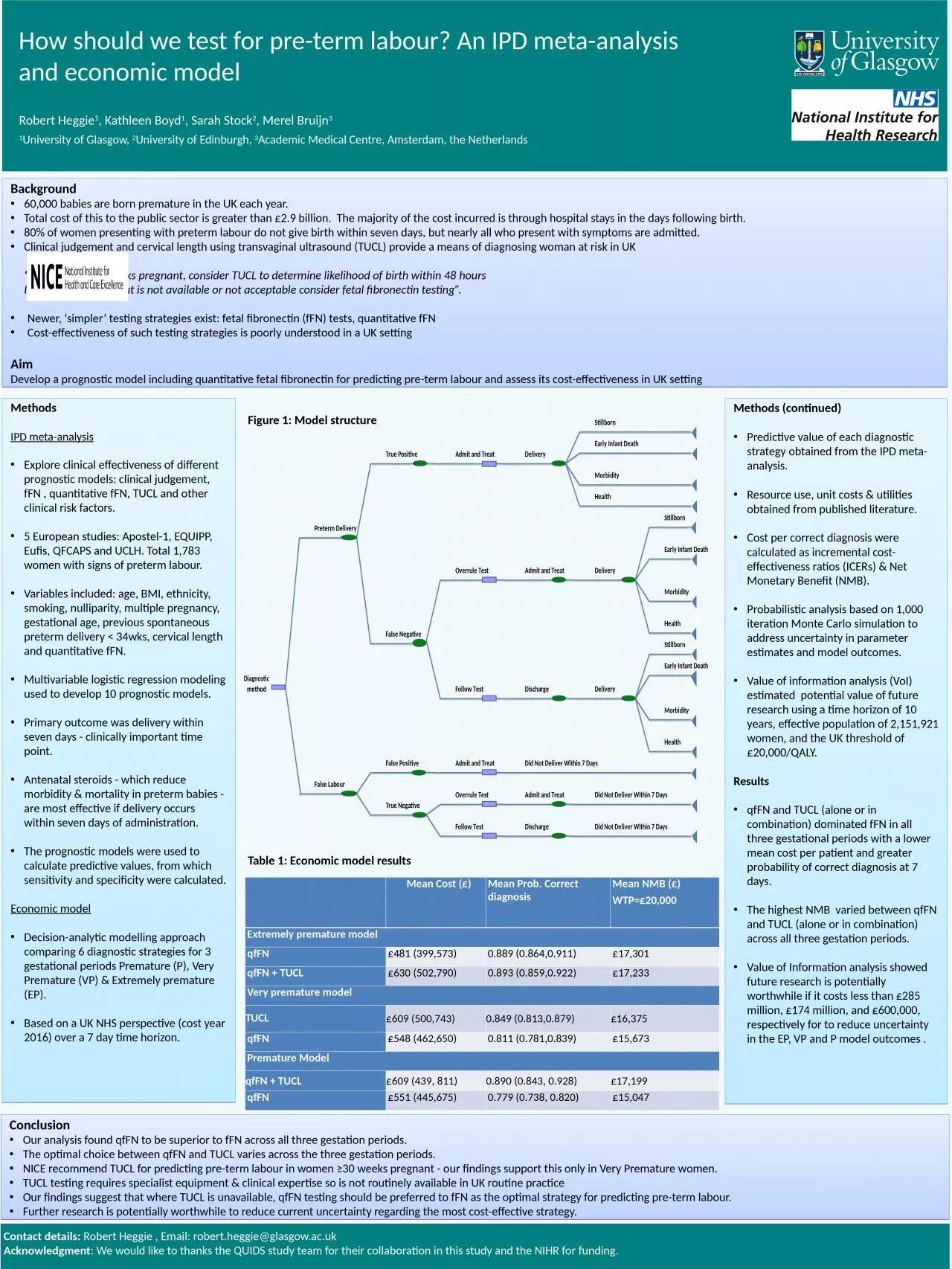

Robert Heggie 1 Kathleen Boyd 1 Sarah Stock 2 Merel Bruijn 3 1 University of Glasgow 2 University of Edinburgh 3 Academic Medical Centre Amsterdam the Netherlands Contact ID: 917920
Download Presentation The PPT/PDF document "How should we test for pre-term labour? ..." is the property of its rightful owner. Permission is granted to download and print the materials on this web site for personal, non-commercial use only, and to display it on your personal computer provided you do not modify the materials and that you retain all copyright notices contained in the materials. By downloading content from our website, you accept the terms of this agreement.
Slide1
How should we test for pre-term labour? An IPD meta-analysis and economic model
Robert Heggie
1, Kathleen Boyd1, Sarah Stock2, Merel Bruijn31University of Glasgow, 2University of Edinburgh, 3Academic Medical Centre, Amsterdam, the Netherlands
Contact
details: Robert Heggie , Email: robert.heggie@glasgow.ac.ukAcknowledgment: We would like to thanks the QUIDS study team for their collaboration in this study and the NIHR for funding.
Background
60,000
babies are born premature in the UK each year. Total cost of this to the public sector is greater than £2.9 billion. The majority of the cost incurred is through hospital stays in the days following birth. 80% of women presenting with preterm labour do not give birth within seven days, but nearly all who present with symptoms are admitted. Clinical judgement and cervical length using transvaginal ultrasound (TUCL) provide a means of diagnosing woman at risk in UK “If woman is 30+ weeks pregnant, consider TUCL to determine likelihood of birth within 48 hours If TUCL is indicated but is not available or not acceptable consider fetal fibronectin testing”.Newer, ‘simpler’ testing strategies exist: fetal fibronectin (fFN) tests, quantitative fFNCost-effectiveness of such testing strategies is poorly understood in a UK settingAimDevelop a prognostic model including quantitative fetal fibronectin for predicting pre-term labour and assess its cost-effectiveness in UK setting
MethodsIPD meta-analysisExplore clinical effectiveness of different prognostic models: clinical judgement, fFN , quantitative fFN, TUCL and other clinical risk factors. 5 European studies: Apostel-1, EQUIPP, Eufis, QFCAPS and UCLH. Total 1,783 women with signs of preterm labour.Variables included: age, BMI, ethnicity, smoking, nulliparity, multiple pregnancy, gestational age, previous spontaneous preterm delivery < 34wks, cervical length and quantitative fFN.Multivariable logistic regression modeling used to develop 10 prognostic models.Primary outcome was delivery within seven days - clinically important time point.Antenatal steroids - which reduce morbidity & mortality in preterm babies - are most effective if delivery occurs within seven days of administration. The prognostic models were used to calculate predictive values, from which sensitivity and specificity were calculated.Economic modelDecision-analytic modelling approach comparing 6 diagnostic strategies for 3 gestational periods Premature (P), Very Premature (VP) & Extremely premature (EP).Based on a UK NHS perspective (cost year 2016) over a 7 day time horizon.
Methods (continued)Predictive value of each diagnostic strategy obtained from the IPD meta-analysis.Resource use, unit costs & utilities obtained from published literature.Cost per correct diagnosis were calculated as incremental cost-effectiveness ratios (ICERs) & Net Monetary Benefit (NMB).Probabilistic analysis based on 1,000 iteration Monte Carlo simulation to address uncertainty in parameter estimates and model outcomes.Value of information analysis (VoI) estimated potential value of future research using a time horizon of 10 years, effective population of 2,151,921 women, and the UK threshold of £20,000/QALY.ResultsqfFN and TUCL (alone or in combination) dominated fFN in all three gestational periods with a lower mean cost per patient and greater probability of correct diagnosis at 7 days.The highest NMB varied between qfFN and TUCL (alone or in combination) across all three gestation periods.Value of Information analysis showed future research is potentially worthwhile if it costs less than £285 million, £174 million, and £600,000, respectively for to reduce uncertainty in the EP, VP and P model outcomes .
ConclusionOur analysis found qfFN to be superior to fFN across all three gestation periods. The optimal choice between qfFN and TUCL varies across the three gestation periods.NICE recommend TUCL for predicting pre-term labour in women ≥30 weeks pregnant - our findings support this only in Very Premature women. TUCL testing requires specialist equipment & clinical expertise so is not routinely available in UK routine practiceOur findings suggest that where TUCL is unavailable, qfFN testing should be preferred to fFN as the optimal strategy for predicting pre-term labour.Further research is potentially worthwhile to reduce current uncertainty regarding the most cost-effective strategy.
Table 1: Economic model results
Figure 1: Model structure
Mean Cost (£)Mean Prob. Correct diagnosisMean NMB (£)WTP=£20,000Extremely premature modelqfFN £481 (399,573)0.889 (0.864,0.911)£17,301qfFN + TUCL£630 (502,790)0.893 (0.859,0.922)£17,233Very premature modelTUCL£609 (500,743)0.849 (0.813,0.879)£16,375qfFN£548 (462,650)0.811 (0.781,0.839)£15,673Premature Model qfFN + TUCL £609 (439, 811)0.890 (0.843, 0.928)£17,199qfFN£551 (445,675)0.779 (0.738, 0.820)£15,047